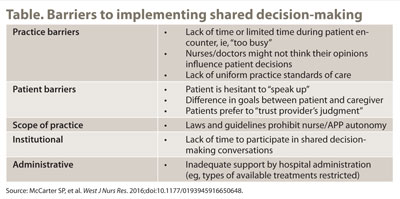Shared decision-making in cancer treatment ‘worth the effort’
Editor’s note: HemOnc Today’s regular columns for advanced practice providers (APPs) tackle common issues APPs face, discuss day-to-day practice and regulatory concerns, and share research advances. To contribute to this column, contact Alexandra Todak at stodak@healio.com.
The science of health care delivery has continued to evolve over the last 20 to 30 years and, more recently, with a rapid pace.
Patient-centered care has become the focus of many health care systems. This is especially true in light of the numerous treatment and supportive innovations that aim to successfully enhance one’s quantity — and often — quality of life. Now, more than ever, engaging individuals and their caregivers regarding treatment and diagnostic decisions is considered integral to quality, patient-centered care.

Recommending treatment based on patient desires has become increasingly important, with a paradigm shift that results in higher patient satisfaction ratings and better adherence to treatment compared with prior paternalistic, physician-controlled decision-making models of the past. Lower ratings of care quality and physician communication scores have been associated with paternalistic models.
Models to implement shared decision-making into one’s clinical practice and measures to evaluate patient-reported outcomes have been proposed. This column will describe the benefits of shared decision-making and methods to implement it into clinical practice.
Defining shared decision-making
Shared decision-making is a process in which patients, caregivers, physicians and allied health members work together to make decisions regarding one’s treatment, test selections and overall medical care. This shared decision-making process is exceedingly important in cancer care, where patient preferences are regarded as highly important — especially when treatments are somewhat equal.
The shared decision-making model takes into account the risks, benefits and alternatives to the available treatments or procedures and seeks to balance the physical (eg, transportation for visits, length of time invested at the hospitals), financial (out-of-pocket costs of care to the patient), and physiological (side effects) burdens associated with treatments.
Key components of shared decision-making rely on patient and provider involvement and can be categorized into four essential elements:
Benefits of shared decision-making
Research into the benefits of shared decision-making as it relates to patients with cancer over the last 2 decades has shown that many patients realize an increased confidence and a higher level of satisfaction with treatment decisions. Patients report higher levels of trust among health care team members and perceive the providers have the patient’s best interests in mind.
Forming a relationship and trust between the patient and provider leads to improved treatment adherence. Because deciding among available treatments for cancer can lead to patient and caregiver decisional regrets and anxiety, allowing time for the shared decision-making process can help minimize regret and alleviate anxiety.
Shared decision-making in practice
APP and nurse participation is critical to a successful shared decision-making process, as these individuals have been shown to influence patient decisions.
Barriers to implementing shared decision-making have been described and include those that are practice related, patient related, institutional and administrative, as well as those dictated by the scope of practice (Table). Knowledge of these barriers will allow the APP to identify and potentially modify for successful implementation.

The shared decision-making model can be executed by all providers, and is most likely a routine part of clinical practice.
First, the provider should review the process of shared decision-making with patients and caregivers, and invite them to participate. Once patients agree to take an active role in decision-making, a time is set — either in the present or in a future encounter — to discuss available treatment options. If numerous options are available, it would be best to discuss the pros and cons of the most realistic options when the provider balances the risks and the data behind the decision, with general knowledge of patient goals and health status. It is imperative that the provider ensure that patients and caregivers understand the information given to them by asking the patient and/or caregiver to repeat the information.
A next step would be to discuss the patient and/or caregiver’s personal preferences, values, issues and concerns related to treatment options. Find out what is most important to the patient and caregiver. Allowing the patient and/or caregiver the opportunity to think about available options in the context of what is important to them (eg, oral regimens vs. IV regimens, if applicable) is recommended as long as the treatment decision is not an urgent medical emergency.
Once all treatment options, as well as the pros and cons of each are discussed, a decision can be reached. Final steps include ensuring that all parties understand the details of what is decided with written information provided to the patient and/or caregiver.
The process of shared decision-making undoubtedly takes time, but eliciting the assistance of multidisciplinary team members such as APPs, RNs and pharmacists can help to reinforce recommendations and allow the patient to come to a treatment decision they can feel somewhat comfortable with.
The implementation of shared decision-making takes time, but the potential benefits — patient satisfaction, potential for improved quality of life and adherence to treatment — are worth the effort.
References:
Barr PJ and Elwyn G. Health Expect. 2016;doi:10.1111/hex.12380.
Elwyn G, et al. J Gen Intern Med. 2012;doi:10.1007/s11606-012-2077-6.
Kane HL, et al. CA: Cancer J Clin. 2014;doi:10.3322/caac.21245.
Kehl KL, et al. JAMA Oncol. 2015;doi:10.1001/jamaoncol.2014.112.
McCarter SP, et al. West J Nurs Res. 2016;doi:10.1177/0193945916650648.
Tariman JD, et al. Clin J Oncol Nurs. 2016; doi:10.1188/16.CJON.560-563.
Vortel MA, et al. Patient Educ Couns. 2016;doi:10.1016/j.pec.2016.03.024.
For more information:
Beth Faiman PhD, MSN, APRN-BC, AOCN, is a nurse practitioner in the department of hematology and medical oncology at Cleveland Clinic Taussig Cancer Institute. She can be reached at faimanb@ccf.org.
Disclosure: Faiman reports speaker and consultant roles with Bristol-Myers Squibb, Celgene and Takeda.
